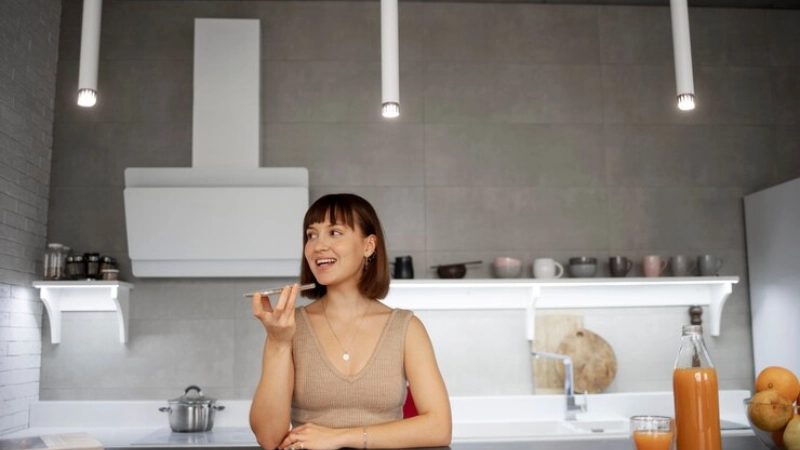
Lighting plays a pivotal role in creating a perfectly lit kitchen that is not only functional but also beautiful. As the heart of the home, the kitchen needs to be well-lit to help with food prep, cooking, cleaning, and entertaining. With the right lighting, you can create a space that feels both inviting and efficient. To help you achieve the ultimate kitchen lighting setup, we spoke with experts in design and lighting to bring you the top 10 steps for a perfectly lit kitchen.
1. Understand the Three Layers of Lighting
When planning your kitchen lighting, it’s essential to understand the three fundamental layers: ambient, task, and accent lighting. These three types work together to create a balanced and versatile lighting environment.
- Ambient lighting is the primary source of light that illuminates the entire room. It typically comes from overhead fixtures such as recessed lights or ceiling-mounted pendants. Ambient lighting sets the mood and provides a foundation for the space.
- Task lighting is more focused and illuminates specific work areas, such as countertops, sinks, and stoves. Under-cabinet lighting, pendant lights, and track lighting are examples of task lighting.
- Accent lighting adds drama and highlights certain features in the kitchen. This could include lighting for artwork, display shelves, or architectural features. Accent lighting creates visual interest and helps highlight the aesthetic elements of your kitchen.
2. Start with Ambient Lighting
The first layer of your kitchen lighting plan should be ambient lighting. This is the foundation of your space and provides the overall illumination. Overhead ceiling lights are typically the most common source of ambient lighting in a kitchen. However, the type of fixture you choose can make a big difference.
Consider installing dimmable recessed lighting or a pendant light over the central island. The key is to create a soft, even light that spreads throughout the room without overpowering any one area.
- Tip: Choose fixtures with a high CRI (Color Rendering Index) to ensure that colors in the kitchen look natural and vibrant. A CRI of 80 or higher is ideal for kitchen lighting.
3. Layer with Task Lighting
Once your ambient lighting is in place, add task lighting to illuminate areas where cooking and food prep take place. These areas need bright, direct light to make tasks such as chopping vegetables or reading recipes easier.
Under-cabinet lighting is a popular choice for task lighting as it directs light onto the countertops without casting shadows. LED strips or puck lights are great options for this application. These lights are energy-efficient and provide bright, focused illumination.
Pendant lights above the kitchen island also serve as excellent task lighting, especially when the island is used for meal prep, dining, or gathering. Select pendants that provide ample light without obstructing sightlines or feeling too harsh.
- Tip: Task lighting should be bright enough to ensure visibility but soft enough not to create glare. Aim for around 100-200 lux (lumens per square meter) in task areas.
4. Create Ambiance with Accent Lighting
Accent lighting adds personality and visual interest to your kitchen. Use it to highlight architectural features, such as a backsplash, a range hood, or an attractive piece of artwork. Accent lighting helps set the mood and makes the kitchen feel more inviting.
LED strip lights are perfect for under-cabinet or under-shelf accent lighting, casting a warm glow and emphasizing your kitchen’s best features. Consider placing small LED spotlights to showcase decorative items or plants. If you have an open shelving unit, place lights inside to illuminate your favorite dishware or cookbooks.
- Tip: Accent lighting should not overpower task lighting. It should be soft and subtle, designed to create shadows and highlights that enhance the atmosphere without being too bright.
5. Prioritize the Work Triangle
The work triangle—the area between your sink, stove, and refrigerator—is where most kitchen tasks happen. For optimal efficiency and functionality, your lighting should be designed to support this important zone.
Ensure that all three points of the work triangle are well-lit with a combination of ambient, task, and accent lighting. For example, install under-cabinet lights to brighten the counter next to the stove, as this is often the most used area. Pendant lights over the sink can provide direct light while adding visual appeal.
- Tip: Make sure the work triangle is evenly lit. A poorly lit area can disrupt your cooking flow and make tasks more challenging.
6. Embrace Natural Light
Natural light is an excellent way to make your kitchen feel more spacious and welcoming. If your kitchen has windows, be sure to maximize the amount of daylight that enters the room. Natural light helps balance artificial lighting and creates a healthier, more pleasant atmosphere.
To enhance the flow of natural light, use light-colored materials, such as white or pale cabinetry, countertops, and walls. Avoid heavy drapes that block sunlight—opt for sheer curtains or blinds that allow light to filter in while providing privacy when needed.
- Tip: Install a skylight if possible. Skylights bring in abundant natural light, especially in kitchens that may not have many windows, creating a bright, airy environment.
7. Choose the Right Light Fixtures
The type of light fixtures you choose will greatly affect the look and feel of your kitchen. A combination of different styles can provide both functionality and aesthetics.
- Pendant lights: These are ideal for above islands or breakfast bars. They provide focused task lighting while serving as a statement piece.
- Recessed lighting: These lights are sleek and unobtrusive. They can be used throughout the kitchen to provide even ambient light.
- Track lighting: Track lights allow you to direct the light where you need it most. They’re flexible and can be used to illuminate work areas or add accent lighting.
Choose fixtures that complement your kitchen’s design. If you have a modern kitchen, go for minimalist, contemporary fixtures like sleek pendant lights. In contrast, if you have a more rustic or traditional design, consider vintage-style sconces or chandeliers.
- Tip: Choose light fixtures that match your kitchen’s aesthetic. A mismatched lighting scheme can detract from the overall design.
8. Utilize Dimmers for Flexibility
Adding dimmers to your light fixtures gives you complete control over the ambiance and intensity of your kitchen lighting. This is especially helpful in a kitchen where you may want bright task lighting during cooking but a softer, warmer light when entertaining or dining.
Dimmers allow you to adjust the lighting to suit the time of day, the task at hand, or the mood you wish to create. For example, in the evening, you may want to dim the lights for a cozy, relaxed vibe, while during the day, you may want brighter lighting for meal prep.
- Tip: Install dimmers for all key lighting layers—ambient, task, and accent—to ensure that your kitchen lighting is versatile.
9. Consider Smart Lighting
Smart lighting has become an increasingly popular choice for modern kitchens. With smart bulbs, you can control the brightness, color, and even the timing of your lights via your smartphone or voice commands.
This technology allows you to create preset lighting scenes for various activities—whether you’re preparing dinner, hosting a dinner party, or simply enjoying a cup of coffee. You can even set your lights to turn on or off automatically when you enter or leave the room.
- Tip: Invest in smart bulbs or a smart lighting system to add convenience and flexibility to your kitchen lighting setup.
10. Don’t Forget Safety and Maintenance
Proper lighting ensures that your kitchen is both functional and safe. Make sure that key work areas are well-lit to prevent accidents while chopping or cooking. Avoid placing lights in areas that could create glare, especially over the stove or sink.
Additionally, regular maintenance is essential for keeping your kitchen lighting in top shape. Clean light fixtures and replace burnt-out bulbs as needed to maintain consistent lighting.
- Tip: Check for potential hazards like exposed wires or improperly installed fixtures that could lead to accidents. Also, opt for LED bulbs, which have a longer lifespan and consume less energy.
Conclusion
A well lit kitchen is more than just a practical necessity—it’s an integral part of creating a welcoming and efficient space. By incorporating a mix of ambient, task, and accent lighting, you can enhance your kitchen’s functionality while also elevating its visual appeal. Keep these 10 steps in mind as you plan your kitchen lighting, and you’ll soon enjoy a space that’s not only beautifully lit but perfectly suited to your cooking and entertaining needs.






No comment yet, add your voice below!